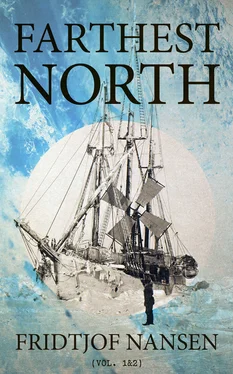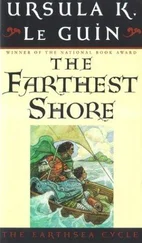The strength of our people now dwindled away, and centuries elapsed before explorers once more sought the northern seas. Then it was other nations, especially the Dutch and the English, that led the van. The sober observations of the old Northmen were forgotten, and in their stead we meet with repeated instances of the attraction of mankind towards the most fantastic ideas; a tendency of thought that found ample scope in the regions of the north. When the cold proved not to be absolutely deadly, theories flew to the opposite extreme, and marvellous were the erroneous ideas that sprang up and have held their own down to the present day. Over and over again it has been the same—the most natural explanation of phenomena is the very one that men have most shunned; and, if no middle course was to be found, they have rushed to the wildest hypothesis. It is only thus that the belief in an open polar sea could have arisen and held its ground. Though everywhere ice was met with, people maintained that this open sea must lie behind the ice. Thus the belief in an ice-free northeast and northwest passage to the wealth of Cathay or of India, first propounded towards the close of the 15th century, cropped up again and again, only to be again and again refuted. Since the ice barred the southern regions, the way must lie farther north; and finally a passage over the Pole itself was sought for. Wild as these theories were, they have worked for the benefit of mankind; for by their means our knowledge of the earth has been widely extended. Hence we may see that no work done in the service of investigation is ever lost, not even when carried out under false assumptions. England has to thank these chimeras in no small degree for the fact that she has become the mightiest seafaring nation of the world.
By many paths and by many means mankind has endeavored to penetrate this kingdom of death. At first the attempt was made exclusively by sea. Ships were then ill adapted to combat the ice, and people were loath to make the venture. The clinker-built pine and fir barks of the old Northmen were no better fitted for the purpose than were the small clumsy carvels of the first English and Dutch Arctic explorers. Little by little they learnt to adapt their vessels to the conditions, and with ever-increasing daring they forced them in among the dreaded floes.
But the uncivilized polar tribes, both those that inhabit the Siberian tundras and the Eskimo of North America, had discovered, long before polar expeditions had begun, another and a safer means of traversing these regions—to wit, the sledge, usually drawn by dogs. It was in Siberia that this excellent method of locomotion was first applied to the service of polar exploration. Already in the 17th and 18th centuries the Russians undertook very extensive sledge journeys, and charted the whole of the Siberian coast from the borders of Europe to Bering Strait. And they did not merely travel along the coasts, but crossed the drift-ice itself to the New Siberian Islands, and even north of them. Nowhere, perhaps, have travellers gone through so many sufferings, or evinced so much endurance.
In America, too, the sledge was employed by Englishmen at an early date for the purpose of exploring the shores of the Arctic seas. Sometimes the toboggan or Indian sledge was used, sometimes that of the Eskimo. It was under the able leadership of M’Clintock that sledge journeys attained their highest development. While the Russians had generally travelled with a large number of dogs, and only a few men, the English employed many more men on their expeditions, and their sledges were entirely, or for the most part, drawn by the explorers themselves. Thus in the most energetic attempt ever made to reach high latitudes, Albert Markham’s memorable march towards the north from the Alert’s winter quarters, there were 33 men who had to draw the sledges, though there were plenty of dogs on board the ship. It would appear, indeed, as if dogs were not held in great estimation by the English.
The American traveller Peary has, however, adopted a totally different method of travelling on the inland ice of Greenland, employing as few men and as many dogs as possible. The great importance of dogs for sledge journeys was clear to me before I undertook my Greenland expedition, and the reason I did not use them then was simply that I was unable to procure any serviceable animals. 2
A third method may yet be mentioned which has been employed in the Arctic regions—namely, boats and sledges combined. It is said of the old Northmen in the Sagas and in the Kongespeilet , that for days on end they had to drag their boats over the ice in the Greenland sea, in order to reach land. The first in modern times to make use of this means of travelling was Parry, who, in his memorable attempt to reach the Pole in 1827, abandoned his ship and made his way over the drift-ice northward with boats, which he dragged on sledges. He succeeded in attaining the highest latitude (82° 45′) that had yet been reached; but here the current carried him to the south more quickly than he could advance against it, and he was obliged to turn back.
Of later years this method of travelling has not been greatly employed in approaching the Pole. It may, however, be mentioned that Markham took boats with him also on his sledge expedition. Many expeditions have through sheer necessity accomplished long distances over the drift-ice in this way, in order to reach home after having abandoned or lost their ship. Especial mention may be made of the Austro-Hungarian Tegethoff expedition to Franz Josef Land, and the ill-fated American Jeannette expedition.
It seems that but few have thought of following the example of the Eskimo—living as they do, and, instead of heavy boats, taking light kayaks drawn by dogs. At all events, no attempts have been made in this direction.
The methods of advance have been tested on four main routes: the Smith Sound route, the sea route between Greenland and Spitzbergen, Franz Josef Land route, and the Bering Strait route.
In later times, the point from which the Pole has been most frequently assailed is Smith Sound, probably because American explorers had somewhat too hastily asserted that they had there descried the open Polar Sea, extending indefinitely towards the north. Every expedition was stopped, however, by immense masses of ice, which came drifting southward, and piled themselves up against the coasts. The most important expedition by this route was the English one conducted by Nares in 1875–76, the equipment of which involved a vast expenditure. Markham, the next in command to Nares, reached the highest latitude till then attained, 83° 20′, but at the cost of enormous exertion and loss; and Nares was of opinion that the impossibility of reaching the Pole by this route was fully demonstrated for all future ages.
During the stay of the Greely expedition (from 1881 to 1884) in this same region, Lockwood attained a somewhat higher record, viz., 83° 24′, the most northerly point on the globe that human feet had trodden previous to the expedition of which the present work treats.
By way of the sea between Greenland and Spitzbergen, several attempts have been made to penetrate the secrets of the domain of ice. In 1607 Henry Hudson endeavored to reach the Pole along the east coast of Greenland, where he was in hopes of finding an open basin and a waterway to the Pacific. His progress was, however, stayed at 73° north latitude, at a point of the coast which he named “Hold with Hope.” The German expedition under Koldeway (1869–70), which visited the same waters, reached by the aid of sledges as far north as 77° north latitude. Owing to the enormous masses of ice which the polar current sweeps southward along this coast, it is certainly one of the most unfavorable routes for a polar expedition. A better route is that by Spitzbergen, which was essayed by Hudson, when his progress was blocked off Greenland. Here he reached 80° 23′ north latitude. Thanks to the warm current that runs by the west coast of Spitzbergen in a northerly direction, the sea is kept free from ice, and it is without comparison the route by which one can the most safely and easily reach high latitudes in ice-free waters. It was north of Spitzbergen that Edward Parry made his attempt in 1827, above alluded to.
Читать дальше












